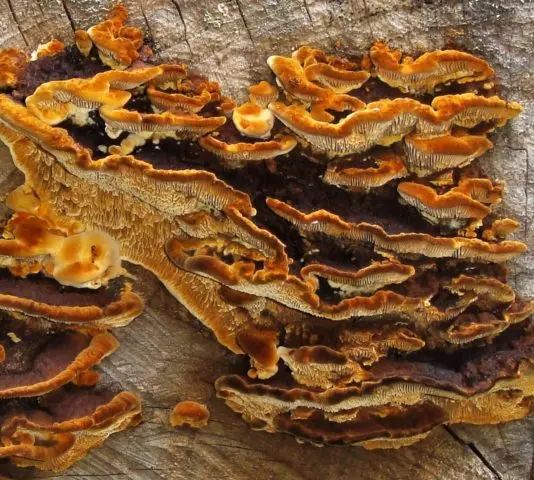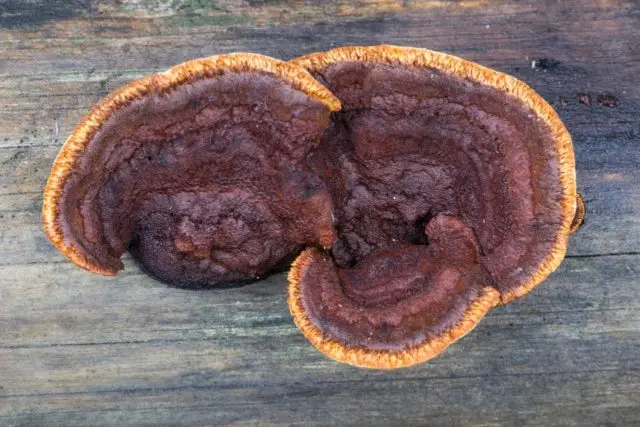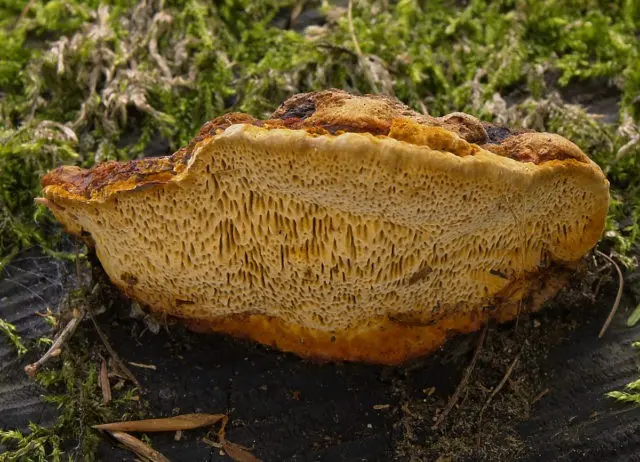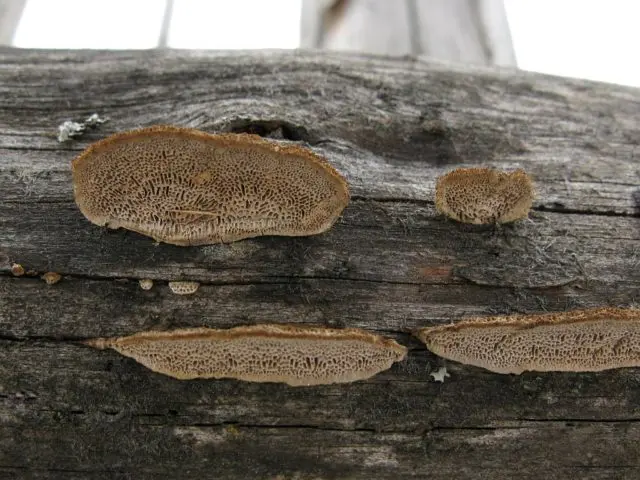Contents
The tinder fungus or gleophyllum intaking in mycological reference books is known as Gloeophyllum sepiarium. The mushroom has several Latin names:
- Daedalea sepiaria;
- Agaricus sepiarius;
- Lenzitina sepiaria;
- Merulius sepiarius.

The species belongs to the genus Gleophyllum of the small Gleophyllum family.
What does Gleophyllum Fence look like?
More often, the gleophyllum is an intaking with an annual biological cycle, less often the growing season lasts two years. There are single specimens or fused laterally, if the fruiting bodies are densely located on the same level of the common plane. The form is half-shaped in the form of a rosette or a fan with a wavy roller along the edge. Fruiting bodies are convex at the beginning of growth, then flat and prostrate with a tiled arrangement on the surface of the substrate.
External characteristic:
- The size of the fruit body in width reaches 8 cm, transverse – up to 15 cm.
- The upper part is velvety in young specimens, at a more mature age it is covered with a short thick and hard pile. The surface is tuberculate with notches of different depths.
- The color at the beginning of growth is bright light brown with an orange tint, darkens to brown with age, then black. The coloration is uneven with pronounced concentric areas: the closer they are to the center, the darker.
- Hymenophore in a species of mixed type. At the beginning of growth, it is formed by small tubes arranged in the form of a labyrinth. With age, the spore-bearing layer becomes lamellar. Plates of irregular various shapes and sizes, dense arrangement.
- The lower part of the mushroom is brown, then dark brown.
The structure of the fruit body is dense cork, the flesh is brown or dark yellow.

Growing edges are always lighter – they are dark yellow or orange
Where and how to grow
Gleophyllum fence is not tied to a specific climatic zone, cosmopolitan grows on dead wood, stumps, deadwood. It occurs in mixed forests dominated by conifers. Saprophyte parasitizes on pine, spruce, cedar. Rarely found on rotting remains of deciduous trees. Prefers open dry areas, edges or clearings. Gleophyllum fence is common in the forests of the northern part of Our Country, the middle lane and in the south.
Gleophyllum fence can be found indoors, where it is located on treated softwood, causing brown rot. In an unnatural environment for themselves, the fruiting bodies are underdeveloped, smaller, sterile. The tinder fungus can be shaped like a coral. It also grows in open areas of wooden outbuildings, fences. In a temperate climate, the growing season is from spring to the onset of frost, in the south – throughout the year.
Is the mushroom edible or not?
Mushrooms do not contain toxic compounds in the chemical composition. The species is of no nutritional value due to the rigid dry structure.
Twins and their differences
Similar species include odorous gleophyllum. Just like the tinder fence, it is inedible. A perennial species, larger and thick-fleshed. The shape is rounded, light yellow in the lower part, with dark brown areas on the surface. Grows singly, scattered, parasitic on rotting coniferous wood. A distinctive feature is a pleasant, well-defined smell of anise.

The fruiting body is cushion-shaped with lamellar hymenophore
Twins include log gleophyllum, a cosmopolitan mushroom that grows on hardwoods, more often on treated wood of buildings. The species is annual, but the biological cycle can last up to two years. It is located singly or in small groups with lateral parts fused together. The spore-bearing layer is mixed: tubular and lamellar. The color is dark gray, the surface is bumpy rough, the flesh is thin. Mushrooms are inedible.

The lower part of the porous structure with cells of different sizes
Conclusion
Gleophyllum fence – saprotroph, parasitizes on dead coniferous rock, can settle on treated wood, causing brown rot. Mushrooms, due to the rigid structure of the fruiting body, do not represent nutritional value. The main accumulation is in temperate regions, less common in the south.









